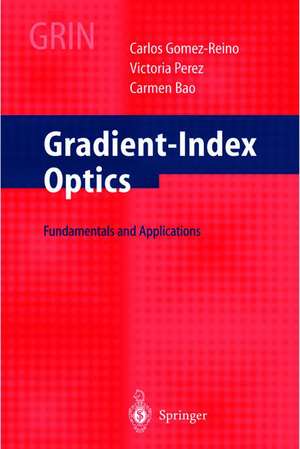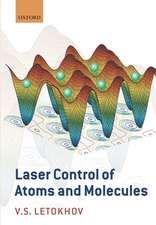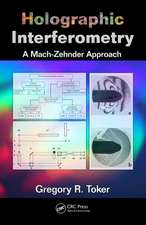Gradient-Index Optics: Fundamentals and Applications
Autor C. Gomez-Reino, M.V. Perez, C. Baoen Limba Engleză Hardback – 22 ian 2002
| Toate formatele și edițiile | Preț | Express |
|---|---|---|
| Paperback (1) | 638.43 lei 6-8 săpt. | |
| Springer Berlin, Heidelberg – 14 oct 2010 | 638.43 lei 6-8 săpt. | |
| Hardback (1) | 643.48 lei 6-8 săpt. | |
| Springer Berlin, Heidelberg – 22 ian 2002 | 643.48 lei 6-8 săpt. |
Preț: 643.48 lei
Preț vechi: 757.04 lei
-15% Nou
Puncte Express: 965
Preț estimativ în valută:
123.13€ • 131.67$ • 102.66£
123.13€ • 131.67$ • 102.66£
Carte tipărită la comandă
Livrare economică 18 aprilie-02 mai
Preluare comenzi: 021 569.72.76
Specificații
ISBN-13: 9783540421252
ISBN-10: 3540421254
Pagini: 256
Ilustrații: XII, 241 p. 17 illus.
Dimensiuni: 155 x 235 x 19 mm
Greutate: 0.5 kg
Ediția:2002
Editura: Springer Berlin, Heidelberg
Colecția Springer
Locul publicării:Berlin, Heidelberg, Germany
ISBN-10: 3540421254
Pagini: 256
Ilustrații: XII, 241 p. 17 illus.
Dimensiuni: 155 x 235 x 19 mm
Greutate: 0.5 kg
Ediția:2002
Editura: Springer Berlin, Heidelberg
Colecția Springer
Locul publicării:Berlin, Heidelberg, Germany
Public țintă
ResearchCuprins
1 Light Propagation in GRIN Media.- 1.1 Introduction.- 1.2 Vector Wave Equations.- 1.3 Scalar Wave Equation.- 1.4 Parabolic Wave Equation.- 1.5 Ray Optics: Axial and Field Rays.- 2 Imaging and Transforming Transmission Through GRIN Media.- 2.1 Introduction.- 2.2 The Kernel Function.- 2.3 Imaging and Fourier Transforming Through GRIN Media.- 2.4 Fractional Fourier Transforming in GRIN Media.- 2.5 Modal Representation of the Kernel.- 3 GRIN Lenses for Uniform Illumination.- 3.1 Introduction.- 3.2 Transmittance Function of a GRIN Lens for Uniform Illumination.- 3.3 GRIN Lens Law: Imaging and Fourier Transforming by GRIN Lens.- 3.4 Geometrical Optics of GRIN Lenses.- 3.5 Effective Radius, Numerical Aperture, Aperture Stop, and Pupils.- 3.6 Diffraction-Limited Propagation of Light in a GRIN lens.- 3.7 Effect of the Aperture on Image and Fourier Transform Formation.- 4 GRIN Lenses for Gaussian Illumination.- 4.1 Introduction.- 4.2 Propagation of Gaussian Beams in a GRIN Lens.- 4.3 GRIN Lens Law: Image and Focal Shifts.- 4.4 Effective Aperture.- 5 GRIN Media with Loss or Gain.- 5.1 Introduction.- 5.2 Active GRIN Materials: Complex Refractive Index.- 5.3 The Kernel Function.- 5.4 Focal Distance and Focal Shift for Uniform Illumination.- 5.5 Gaussian Illumination in an Active GRIN Medium: Beam Parameters.- 5.6 Transformation of a Gaussian Beam into a Uniform Beam.- 6 Planar GRIN Media with Hyperbolic Secant Refractive Index Profile.- 6.1 Introduction.- 6.2 Ray Equation and ABCD Law.- 6.3 Focusing and Collimation Properties.- 6.4 Numerical Aperture: On-Axis and Off-Axis Coupling.- 6.5 Mode Propagation.- 6.6 The Kernel Function.- 6.7 Diffraction-Free and Diffraction-Limited Propagation of Light.- 7 The Talbot Effect in GRIN Media.- 7.1 Introduction.- 7.2 Light Propagation and Imaging Condition.- 7.3 The Integer Talbot Effect.- 7.4 Self-Image Distances.- 7.5 Fractional Talbot Effect: Unit Cell.- 7.6 Effect of Off-Axis Source and Finite Object Dimension on Self-Images.- 8 GRIN Crystalline Lens.- 8.1 Introduction.- 8.2 The Optical Structure of the Human Eye.- 8.3 The GRIN Model of the Crystalline Lens.- 8.4 The Gradient Parameter: Axial and Field Rays in the Crystalline Lens.- 8.5 Refractive Power and Cardinal Points of the Crystalline Lens.- 9 Optical Connections by GRIN Lenses.- 9.1 Introduction.- 9.2 GRIN Fiber Lens.- 9.3 Anamorphic Selfoc Lens.- 9.4 Tapered GRIN Lens.- 9.5 Selfoc Lens.- References.
Textul de pe ultima copertă
Gradient-Index (GRIN) optics provides a comprehensive and thorough treatment on fundamentals and applications of light propagation through inhomogeneous media. The book can be used both as a classroom text for students in physics and engineering and as a reference for specialists. A description of the phenomena, components and technology used in GRIN Optics are presented. The relationship to lenses, waveguides, optical connections, spatial solitons and vision is demonstrated. Applications of GRIN components and hybrid structures for optical connections, optical sensing and Talbot effect are analyzed.
Caracteristici
GRIN optics is an active area of research in telecommunications, sensing and image sciences The book provides an introduction to this field but the main purpose is the treatment of the various applications in todays high technologies Includes supplementary material: sn.pub/extras















